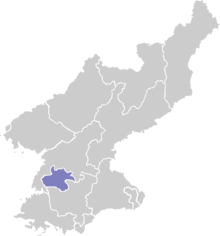Potonggang-guyok
Potonggang-guyok is one of the 18 districts, or guyok, of Pyongyang, North Korea. It is most famous as the location of the Ryugyong Hotel. It is named after the Pothong River (literally "the simple river"), which serves as the district's border on all sides. It is bordered to the north by Hyongjesan-guyok, to the east by Sosong and Moranbong-guyoks, to the south by Pyongchon and Chung-guyoks, and to the west by Mangyongdae-guyok. The district was established by the Pyongyang City People's Committee in October 1960.
Potonggang-guyok | |
|---|---|
Guyŏk of Pyongyang | |
| Korean transcription(s) | |
| • Hangul | 보통강구역 |
| • Hanja | 普通江區域 |
| • Revised Romanization | Botonggang-guyeok |
| • McCune–Reischauer | Pot'onggang-guyŏk |
| Country | North Korea |
| Direct-administered city | P'yŏngyang-Chikhalsi |
| Administrative divisions | 15 administrative dong |
Overview
The Pot'ong District is primarily a working district of the city as the few places of interest to tourists on located on the periphery of the district. The only attractions open to visitors are the Potong River Pleasure Ground, the Victorious Liberation of the Fatherland Statue and the Potong River Improvement Project Monument. It is also the location of the Pyongyang Embroidery School and Factory, and the Pyongyang Senior Middle School. The district's Ragwon-dong is the location of the central offices and headquarters of the DPRK's National Defense Commission.
The Pyongyang Metro runs through this district, with stops at Konsol, Hwanggumbol, and Konguk stations.[1]
Administrative divisions
Potonggang-guyok is divided into fifteen administrative districts known as tong (neighborhoods):[2]
| Chosŏn'gŭl | Hancha | |
|---|---|---|
| Kyŏnghŭng-dong | 경흥동 | 慶興洞 |
| Ponghwa-dong | 봉화동 | 烽火洞 |
| Pot'onggang 1-dong | 보통강1동 | 普通江1洞 |
| Pot'onggang 2-dong | 보통강2동 | 普通江2洞 |
| Pulgŭnkori 1-dong | 붉은거리1동 | 붉은거리1洞 |
| Pulgŭnkori 2-dong | 붉은거리2동 | 붉은거리2洞 |
| Pulgŭnkori 3-dong | 붉은거리3동 | 붉은거리3洞 |
| Rakwŏn-dong | 락원동 | 樂園洞 |
| Ryugyŏng 1-dong | 류경1동 | 柳京1洞 |
| Ryugyŏng 2-dong | 류경2동 | 柳京2洞 |
| Segŏri-dong | 세거리동 | 세거리洞 |
| Sŏjang-dong | 서장동 | 西將洞 |
| Sŏk'am-dong | 석암동 | 石岩洞 |
| Sinwŏn-dong | 신원동 | 新院洞 |
| Taebo-dong | 대보동 | 大寶洞 |
References
- "Archived copy". Archived from the original on 2017-10-26. Retrieved 2013-03-17.CS1 maint: archived copy as title (link)
- http://nk.joins.com/map/i004.htm
